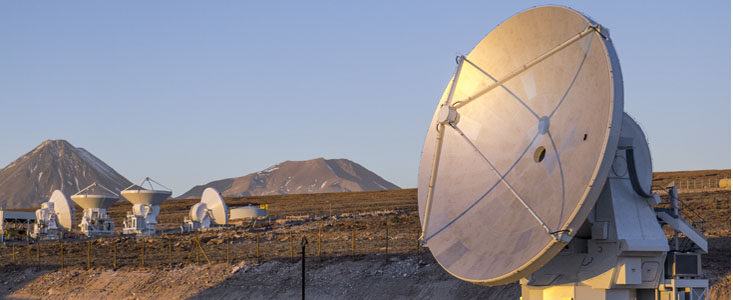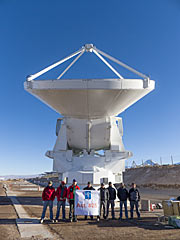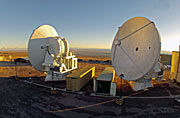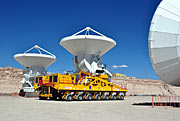Press Release
Final Antenna Delivered to ALMA
All 66 ALMA antennas now handed over to the observatory
1 October 2013
The final antenna for the Atacama Large Millimeter/submillimeter Array (ALMA) project has just been handed over to the ALMA Observatory. The 12-metre-diameter dish was manufactured by the European AEM Consortium and also marks the successful delivery of a total of 25 European antennas — the largest ESO contract so far.
The antenna is the 66th and final antenna to be delivered to the observatory. North America has provided 25 12-metre antennas, while East Asia has delivered 16 (four 12-metre and twelve 7-metre). By the end of 2013, all 66 ultra-precise millimetre/submillimetre-wave radio antennas are expected to be working together as one telescope, in an array that will stretch for up to 16 kilometres across the Chajnantor Plateau in the Atacama Desert of northern Chile.
The ALMA Observatory was inaugurated by the President of Chile, Sebastián Piñera, in March 2013 (eso1312). That event marked the completion of all the major systems of the giant telescope and the formal transition from a construction project to a fully fledged observatory.
This delivery of the last antenna now completes the ALMA antenna construction phase [1] and provides all 66 antennas for science use, marking the beginning of a new era of discoveries in astronomy. “This is an important milestone for the ALMA Observatory since it enables astronomers in Europe and elsewhere to use the complete ALMA telescope, with its full sensitivity and collecting area,” says Wolfgang Wild, the European ALMA Project Manager.
The handover of the final European antenna marks the successful completion of the largest ESO contract so far. The contract with the AEM Consortium [2] covered the design, manufacture, transport and on-site integration of the 25 antennas.
ALMA helps astronomers to answer important questions about our cosmic origins. The telescope observes the Universe using light with millimetre and submillimetre wavelengths, between infrared light and radio waves in the electromagnetic spectrum. Light at these wavelengths comes from some of the coldest, but also from some of the most distant, objects in the cosmos. These include cold clouds of gas and dust where new stars are being born, and remote galaxies towards the edge of the observable Universe.
The Universe is relatively unexplored at submillimetre wavelengths, as the telescopes need extremely dry atmospheric conditions, such as those at Chajnantor, many large antennas and advanced detector technology. Even before completion ALMA has already been used extensively for science projects and has shown great potential with the publication of many exciting science results (see eso1336, eso1334, eso1333, eso1331, eso1325, eso1318, eso1313 and eso1234).
Notes
[1] ESO is also responsible for the construction of the Residencia where visiting staff will be accommodated.
[2] The AEM Consortium is composed of Thales Alenia Space, European Industrial Engineering, and MT-Mechatronics.
More information
ALMA, an international astronomy facility, is a partnership of Europe, North America and East Asia in cooperation with the Republic of Chile. ALMA construction and operations are led on behalf of Europe by the European Southern Observatory (ESO), on behalf of North America by the National Radio Astronomy Observatory (NRAO), and on behalf of East Asia by the National Astronomical Observatory of Japan (NAOJ). The Joint ALMA Observatory (JAO) provides the unified leadership and management of the construction, commissioning and operation of ALMA.
ESO is the foremost intergovernmental astronomy organisation in Europe and the world’s most productive ground-based astronomical observatory by far. It is supported by 15 countries: Austria, Belgium, Brazil, Czechia, Denmark, France, Finland, Germany, Italy, the Netherlands, Portugal, Spain, Sweden, Switzerland and the United Kingdom. ESO carries out an ambitious programme focused on the design, construction and operation of powerful ground-based observing facilities enabling astronomers to make important scientific discoveries. ESO also plays a leading role in promoting and organising cooperation in astronomical research. ESO operates three unique world-class observing sites in Chile: La Silla, Paranal and Chajnantor. At Paranal, ESO operates the Very Large Telescope, the world’s most advanced visible-light astronomical observatory and two survey telescopes. VISTA works in the infrared and is the world’s largest survey telescope and the VLT Survey Telescope is the largest telescope designed to exclusively survey the skies in visible light. ESO is the European partner of a revolutionary astronomical telescope ALMA, the largest astronomical project in existence. ESO is currently planning the 39-metre European Extremely Large optical/near-infrared Telescope, the E-ELT, which will become “the world’s biggest eye on the sky”.
Links
Contacts
Wolfgang Wild
European ALMA Project Manager, ESO
Garching bei München, Germany
Tel: +49 89 3200 6716
Email: wwild@eso.org
Stefano Stanghellini
ALMA Antenna Project Manager, ESO
Garching bei München, Germany
Tel: +49 89 3200 6570
Email: sstanghe@eso.org
Richard Hook
ESO, Public Information Officer
Garching bei München, Germany
Tel: +49 89 3200 6655
Cell: +49 151 1537 3591
Email: rhook@eso.org
About the Release
| Release No.: | eso1342 |
| Name: | Atacama Large Millimeter/submillimeter Array |
| Type: | Unspecified : Technology : Observatory : Facility |
| Facility: | Atacama Large Millimeter/submillimeter Array |






